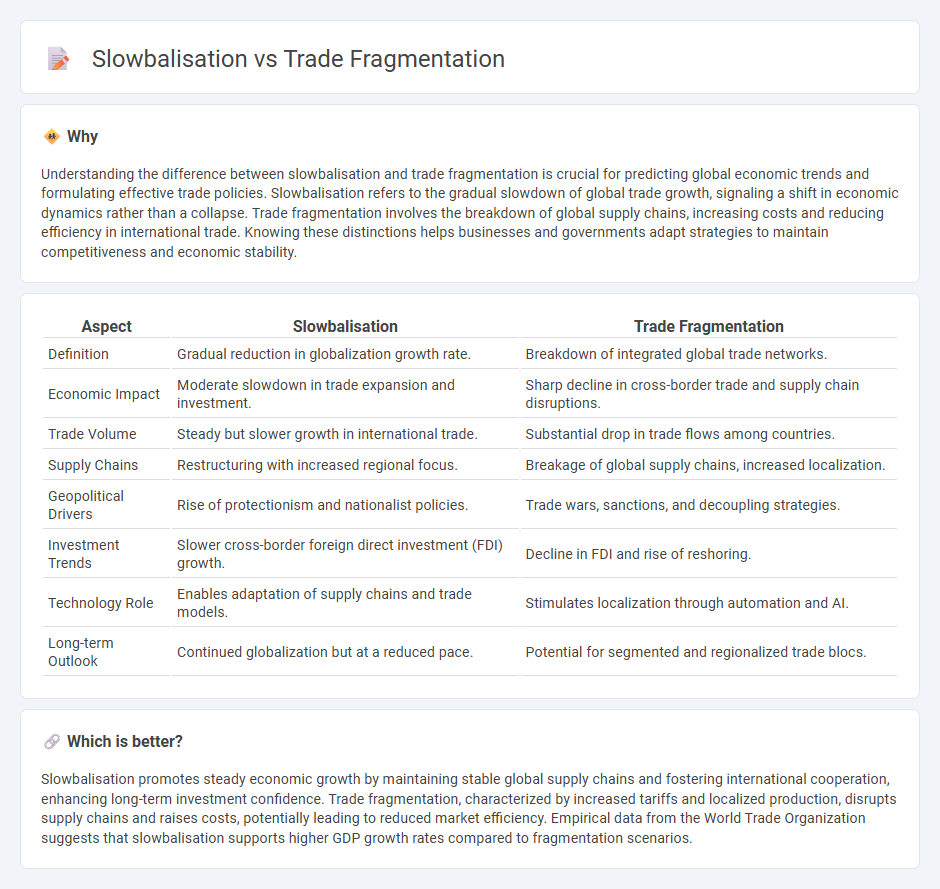
Global economic dynamics are increasingly shaped by slowbalisation, characterized by a deceleration in globalization, and trade fragmentation, marked by the division of supply chains and regionalization of commerce. This shift impacts international trade volumes, cross-border investments, and economic policy coordination among major economies like the US, China, and the EU. Explore the evolving landscape of economic integration to understand how these forces redefine global markets and growth opportunities.
Why it is important
Understanding the difference between slowbalisation and trade fragmentation is crucial for predicting global economic trends and formulating effective trade policies. Slowbalisation refers to the gradual slowdown of global trade growth, signaling a shift in economic dynamics rather than a collapse. Trade fragmentation involves the breakdown of global supply chains, increasing costs and reducing efficiency in international trade. Knowing these distinctions helps businesses and governments adapt strategies to maintain competitiveness and economic stability.
Comparison Table
| Aspect | Slowbalisation | Trade Fragmentation |
|---|---|---|
| Definition | Gradual reduction in globalization growth rate. | Breakdown of integrated global trade networks. |
| Economic Impact | Moderate slowdown in trade expansion and investment. | Sharp decline in cross-border trade and supply chain disruptions. |
| Trade Volume | Steady but slower growth in international trade. | Substantial drop in trade flows among countries. |
| Supply Chains | Restructuring with increased regional focus. | Breakage of global supply chains, increased localization. |
| Geopolitical Drivers | Rise of protectionism and nationalist policies. | Trade wars, sanctions, and decoupling strategies. |
| Investment Trends | Slower cross-border foreign direct investment (FDI) growth. | Decline in FDI and rise of reshoring. |
| Technology Role | Enables adaptation of supply chains and trade models. | Stimulates localization through automation and AI. |
| Long-term Outlook | Continued globalization but at a reduced pace. | Potential for segmented and regionalized trade blocs. |
Which is better?
Slowbalisation promotes steady economic growth by maintaining stable global supply chains and fostering international cooperation, enhancing long-term investment confidence. Trade fragmentation, characterized by increased tariffs and localized production, disrupts supply chains and raises costs, potentially leading to reduced market efficiency. Empirical data from the World Trade Organization suggests that slowbalisation supports higher GDP growth rates compared to fragmentation scenarios.
Connection
Slowbalisation describes the deceleration of global trade growth, driven by rising protectionism and geopolitical tensions that fragment international supply chains. Trade fragmentation occurs as countries diversify sourcing and production, reducing dependency on any single market and creating regional trade blocks. This interconnected dynamic reshapes global economic integration, leading to more localized and resilient trade networks.
Key Terms
Global Value Chains
Trade fragmentation, characterized by the dispersion of production processes across multiple countries, intensifies global value chains (GVCs) by increasing cross-border trade in intermediate goods. Slowbalisation reflects a deceleration in the expansion of GVCs due to rising trade barriers, geopolitical tensions, and shifts towards regionalization and reshoring. Explore the evolving dynamics of trade fragmentation and slowbalisation to understand their impact on the future configuration of global value chains.
Tariffs
Trade fragmentation reflects the division of global supply chains into smaller, regionally concentrated units, often intensifying tariff impacts due to increased cross-border transactions. Slowbalisation denotes a gradual deceleration in global trade growth, influenced by rising tariffs and protectionist policies that hinder international cooperation. Explore how evolving tariff structures shape both trade fragmentation and slowbalisation dynamics.
Regionalization
Trade fragmentation emphasizes the division of production processes across multiple countries, enhancing intra-regional supply chains and efficiency within specific geographic areas. Slowbalisation reflects a broader trend of decelerating global trade growth, with economies focusing more on regionalization to mitigate risks and leverage local markets. Explore in-depth analyses on how regionalization shapes modern trade dynamics and economic strategies.
Source and External Links
The Fed - Assessing the Extent of Trade Fragmentation - Trade fragmentation refers to shifts in trade flows, particularly between the U.S. and China, driven by perceived risks of future trade disruptions or past events, often linked to tariff changes and strategic sectors like advanced technology products.
Trade, fragmentation, monetary policy and the global economic outlook - Trade fragmentation reflects the geopolitical and trade tensions reshaping global trade patterns, leading to economic blocks with stronger intra-block trade, especially in strategic sectors, raising risks of escalating geoeconomic fragmentation.
Global Trade Fragmentation. An EU Perspective - Global trade fragmentation is a policy-driven rearrangement of global value chains and trade flows triggered by geopolitical tensions, trade restrictions, and crises like the pandemic and Russia-Ukraine war, threatening globalisation and multilateralism.
 dowidth.com
dowidth.com